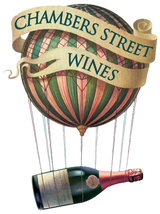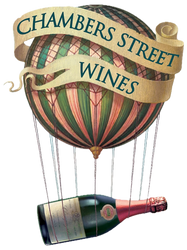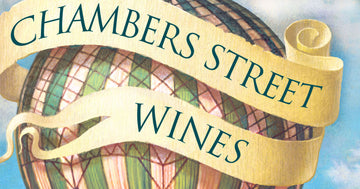Late May Beaujolais - Featuring Chamonard, Descombes, Jean-Marc Burgaud, Julie Balagny and Christian & Thibaut Ducroux
5/27/25 -

The reminder from the wall of a little auberge in Beaujolais is straightforward: "A meal without wine is a day without sun." Today's late May Beaujolais offering focuses on producers that we have championed for years, if not decades, here at Chambers Street. All of these winemakers work (or worked) in stark contrast to the overwhelming majority of industrial producers and co-ops in the region, without spraying pesticides and fungicides on their vineyards (in Beaujolais, the difference between chemically farmed vineyards and organically farmed vineyards is incredibly evident, with brown, lifeless soil vs. lush green plots). Harvesting is by hand, fermentation always with indigenous yeast, and the wines leap out of the bottle with vibrant acidity, beautiful red fruit, and mineral depth. We celebrate some favorites: Domaine Chamonard and winemaker "le Chat," Jean-Claude Chanudet, Georges Descombes, and the late Julie Balagny, whose smile and warmth were incredibly infectious and who touched every soul who met her. Also, as a special pre-offer, we're including Christian Ducroux, whose son Thibaut (no relation to another Beaujolais producer, Thibault Ducroux) has joined the estate and officially taken over as of this year!

(Geneviève Chanudet (born Chamonard) and Jean-Claude Chanudet)
Domaine J. Chamonard
Joseph Chamonard was one of the first growers in Morgon to adopt the ideas of Jules Chauvet and quietly made some of the greatest Beaujolais on his small estate. His daughter Genevieve and her husband Jean-Claude Chanudet took over the estate in 1990 and have continued to make small quantities of superb Morgon. Not as well known as Lapierre, Foillard, Descombes and other "stars" of the region, the wines of Domaine Chamonard are certainly of equal quality and deserve your attention. Although M. Chanudet eschews "biologique" certification, the vineyard work is exemplary, with only organic treatments and plowing in spring and early summer. The domaine has about 4 hectares of massale-selection vines averaging over 60 years-old, principally in the parcels of les Martillets, Chenes and Corcelette, planted at 10,000 vines per hectare. Harvests are late for maximum ripeness. Chanudet's winemaking is similar to others in Morgon, with a low temperature soak and a combination of carbonic maceration and conventional fermentation with indigenous yeasts, followed by 8 to 12 months in foudre. While the Chamonard Morgons are always fairly rich, full, and easthy but also lifted and balanced by their minerality and acidity. The 2021 Fleurie and 2020 Morgon are fantastic examples, ready to drink now or age for 5-10 years.

(Georges Descombes with Eben Lillie, March 2025)
Georges Descombes
We find the wines of Georges Descombes to be among the finest and most consistent of the Beaujolais Crus, always with moderate alcohol, lovely complex fruit and beautiful expression of each terroir. And of course the organic farming and minimal use of SO2 give the wines an extra dimension of purity and complexity of fruit. Located in Vermont, a tiny hamlet in Villié-Morgon, Georges Descombes is the unofficial fifth member of the iconic "Gang of Four": Marcel Lapierre, Jean Foillard, Jean-Paul Thévenet and Guy Breton. Georges took over the estate from his father in 1988, and immediately started shifting viticultural and oenological practices forward by practicing organic viticulture and eliminating all entrants or manipulation during vinification. A minuscule dose of sulfur is usually added before bottling to help preserve the wines. Grapes are hand-harvested, then stored in a temperature controlled container before being placed in 60 hl cement tanks. A traditional, semi-carbonic maceration occurs, and the wine ferments from its ambient yeasts. For each Cru, Georges produces old vine cuvées which are vinified separately, then aged in barrel twelve months before bottling.

Julie Balagny
I had the great pleasure of meeting Julie Balagny several times before she passed away, including spending an entire day with her, from a lunchtime feast in her courtyard, to preparation of biodynamic treatments at her chai, to a visit to the Dutraive estate, and drinks in the town of Fleurie. It was perhaps the most at home I'd ever felt on a visit with a winemaker, as we (myself and my colleague Amanda) were welcomed as friends, not wine retailers or industry. We talked about her being one of the few women winemakers in the Beaujolais scene, she showed us a book about her great (great-great?) grandfather, Georges Balagny, who, according to Julie, invented the photographic technology that Kodak (his colleague and co-inventor) later took full credit for. We did drink wine, but of all my visits over the years, it was the most unique in that we simply joined Julie for a day in her life, without the typical barrel samples and technical talk. I'll never forget this special soul.
-Eben Lillie

As a further homage, I'm including an excerpt from the piece written in 2023 by friend of the store, Aaron Ayscough, from his blog, Not Drinking Poison - entitled: Remembering Julie Balagny
"Internationally-beloved Fleurie vigneronne Julie Balagny passed away suddenly on July 1st at the age of forty-five. The cause was a heart attack, which occurred in the painfully novelistic circumstance of the wedding of her half-sister, a cardiologist. As sensational in life as in death, Balagny leaves behind an acclaimed career in which she forged a more radical aesthetic path than that of her stylistic forebears in the Beaujolais, even as her picturesque lifestyle - that of a courageous, independent neo-vigneronne, surrounded by farm animals - helped inspire untold numbers of friends, disciples, and fans.
Balagny moved to the Beaujolais in 2009, acquiring a patch of old-vine Fleurie with the encouragement of appellation luminary Yvon Métras. By the middle of the following decade, she had emerged as a pivotal figure within Beaujolais natural wine culture: its most prominent and acclaimed proponent of cool carbonic maceration with zero sulfite addition. Like the work of her friends Jean-Louis Dutraive and Paul-Henri Thillardon, Balagny’s rosy, soulful gamays tended to unite Lapierre-era classicists and zero-zero radicals alike in admiration.
Among Beaujolais winemakers, Balagny was distinguished as much by her broad knowledge of natural wine culture - refined during her years as winemaker at Nîmes estate Terre des Chardons - as by her origins in the tony Paris suburb of Saint Cloud.
To anyone who asked, Balagny would cheerfully admit to being the black sheep in a family of doctors and ballet dancers. Her ramshackle, fixer-upper farmstead in the hamlet of Moulin-à-Vent, where she lived among actual sheep (and chickens, dogs, ducks, volunteers, and various lost souls), often seemed like an extravagant repudiation of her upbringing. But it also evidenced the genuine, wide-eyed love Balagny felt for her adoptive rural winemaking milieu.
In such a way, she had something in common with natural wine fanatics the world over." - Aaron Ayscough

Thank you, Julie!
For those who are curious to read more about this wonderful vigneron and human being, click here for "Remembering Our Friend Julie Balagny" from our friends at Louis/Dressner Selections
--------------
Jean-Marc Burgaud
It turns out we don't have a lot of copy on Jean-Marc Burgaud, but our sifu David Lillie insisted that this Beaujolais offer needed some of the fantastic wines from Burgaud, so we're including two cuvées, selected by DL. He's remarked that Burgaud wines are always well-balanced and delicious and very reasonably priced given their very high quality!
"Javernières" is a beautiful parcel on the south-east corner of the Cote de Py, where the thicker topsoil with more clay and iron oxide gives a more generous wine. The 2022 from Burgaud is powerful and dense, but with a lovely freshness not typical in this rather warm vintage. Perhaps more forward than the Desvignes' version, the wine shows gorgeous red and black fruits in a quite velvety style, but is certainly structured enough for 5 to 10 years of cellaring. Drink More Morgon!
Beaujolais-Lantignié is an interesting and undervalued appellation in Beaujolais, partly lying on blue-stone soils as in the Cote de Brouilly, and part on granit sands and rose-colored granit as in Chiroubles. The Burgaud "Vignes de Lantigné" comes from old vines on granit and sandy soils and is a delightfully fresh and pretty wine having floral, cherry and raspberry aromas with lovely, bright red fruits and earth notes on the palate. Serve this quite cool with outdoor meals this summer - it's a perfect quaffing Beaujolais, and a great value!

Christian (and Thibaut) Ducroux - Special pre-order
Chambers Street is honored to work with Christian Ducroux, who produces some of the world's most vibrant and delicious natural wines from his five hectares of living soils in Thulon, above Regnié-Durette in the Beaujolais. The estate has been practising organic and Biodynamic farming, with minimal plowing, (i.e. regenerative agriculture) since 1985. Christian's son Thibaut has now joined his father full-time at the estate - we thank them both for their important and beautiful work!
We tasted the 2023 Expectatia from different barrels. The wine showed beautifully, with gorgeous, deep red and black fruits, lush and ripe with great freshness and balance. This should be fabulous young, but Expectatia ages beautifully so cellaring of up to 10 to 15 years is possible.


